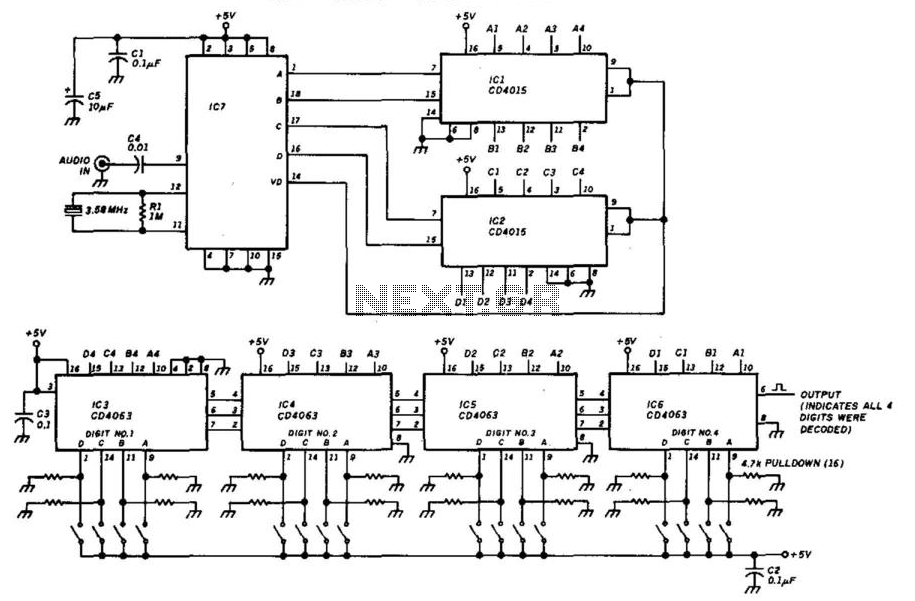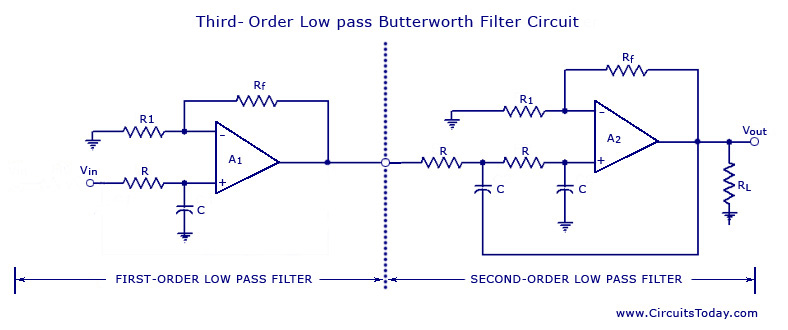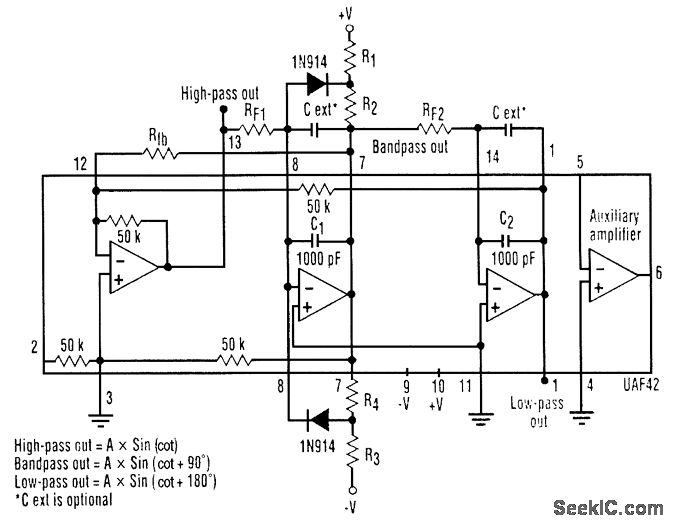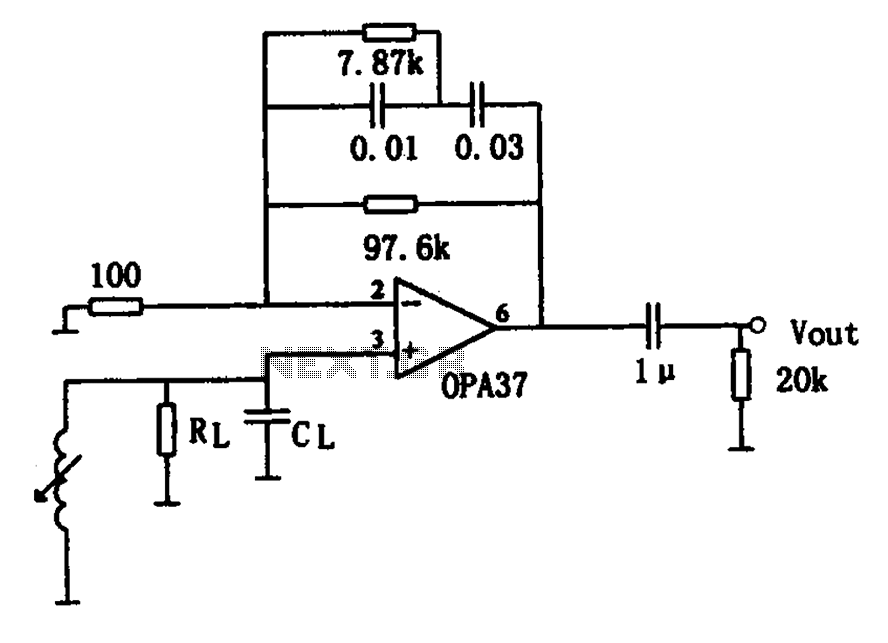
tl062 subwoofer low pass filter
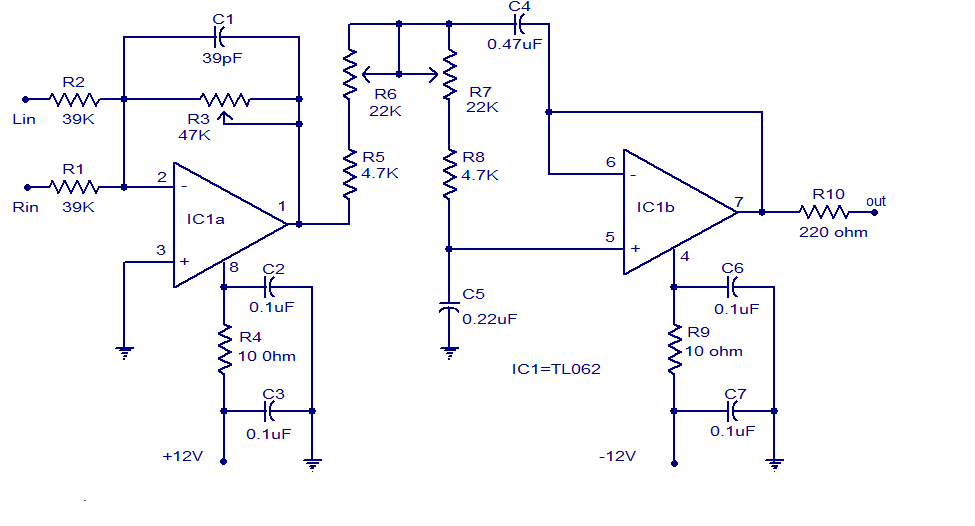
Many low-pass filter circuits for subwoofers are available, and this is another example. The circuit presented here utilizes the TL062 operational amplifier from STMicroelectronics. The TL062 is a dual high-input impedance JFET op-amp known for its low power consumption and high slew rate. It possesses excellent audio characteristics, making it suitable for this application. The first of the two op-amps within the TL062 is configured as a mixer and pre-amplifier stage. The left and right channels are connected to the inverting input of IC1a for mixing. The gain of this initial stage can be adjusted using potentiometer R3. The output from this stage is routed to the input of the second stage through a filter network consisting of components R5, R6, R7, R8, C4, and C5. The second op-amp (IC1b) functions as a buffer, with the filtered output available at pin 7 of the TL062.
The low-pass filter circuit designed for subwoofers effectively attenuates frequencies above a specified cutoff, ensuring that only the desired low-frequency signals are amplified and sent to the subwoofer. The use of the TL062 op-amp is particularly advantageous due to its high input impedance, which minimizes loading on the preceding stages of the audio signal path.
In the first stage, the configuration allows for the mixing of left and right audio channels. The inverting input of IC1a receives signals from both channels, providing a balanced output that is crucial for stereo audio applications. The gain control implemented with potentiometer R3 allows for fine-tuning of the signal level before it is passed to the filtering stage, allowing for customization based on the specific requirements of the subwoofer and the audio system.
The second stage features a filter network composed of resistors R5, R6, R7, R8, and capacitors C4 and C5. This network is designed to create a low-pass filter characteristic, where the cutoff frequency can be determined by the values of these components. The design ensures that high-frequency signals are effectively attenuated, preventing them from reaching the subwoofer, which is optimized for low-frequency reproduction.
The buffer stage provided by IC1b serves to isolate the filter output from subsequent stages, ensuring that the filtered signal remains stable and unaffected by varying loads. The output at pin 7 of the TL062 is the final low-frequency signal, ready to be amplified by the subwoofer amplifier, thus delivering a rich and deep bass response essential for an immersive audio experience. This circuit exemplifies a practical approach to integrating a low-pass filter within a subwoofer system, leveraging the capabilities of the TL062 op-amp to achieve high-quality audio performance.Many low pass filter circuits for subwoofer seem to be given And this is also just Another one. The circuit given here is Depending about the opamp TL062 from one ST Micro electronics. TL062 is really a dual high input impedance J-FET opamp And this has quite low power consumption and high slew rate. The opamp has great audio characteristics and it`s quite suitable for this circuit. Out of those two opamps inside TLC062, initial one is wired as the mixer cum pre amplifier stage. The left and right channel seem to be connected in towards the inverting input of IC1a for mixing. The gain of initial stage seem to be either adjusted using POT R3. The output of those initial stage is connected in towards the input of second stage throughout the filter network comprising of components R5, R6, R7, R8, C4 and C5. The second opamp (IC1b) serves as a buffer and the filtered output is at the pin 7 of those TLC062. 🔗 External reference
The low-pass filter circuit designed for subwoofers effectively attenuates frequencies above a specified cutoff, ensuring that only the desired low-frequency signals are amplified and sent to the subwoofer. The use of the TL062 op-amp is particularly advantageous due to its high input impedance, which minimizes loading on the preceding stages of the audio signal path.
In the first stage, the configuration allows for the mixing of left and right audio channels. The inverting input of IC1a receives signals from both channels, providing a balanced output that is crucial for stereo audio applications. The gain control implemented with potentiometer R3 allows for fine-tuning of the signal level before it is passed to the filtering stage, allowing for customization based on the specific requirements of the subwoofer and the audio system.
The second stage features a filter network composed of resistors R5, R6, R7, R8, and capacitors C4 and C5. This network is designed to create a low-pass filter characteristic, where the cutoff frequency can be determined by the values of these components. The design ensures that high-frequency signals are effectively attenuated, preventing them from reaching the subwoofer, which is optimized for low-frequency reproduction.
The buffer stage provided by IC1b serves to isolate the filter output from subsequent stages, ensuring that the filtered signal remains stable and unaffected by varying loads. The output at pin 7 of the TL062 is the final low-frequency signal, ready to be amplified by the subwoofer amplifier, thus delivering a rich and deep bass response essential for an immersive audio experience. This circuit exemplifies a practical approach to integrating a low-pass filter within a subwoofer system, leveraging the capabilities of the TL062 op-amp to achieve high-quality audio performance.Many low pass filter circuits for subwoofer seem to be given And this is also just Another one. The circuit given here is Depending about the opamp TL062 from one ST Micro electronics. TL062 is really a dual high input impedance J-FET opamp And this has quite low power consumption and high slew rate. The opamp has great audio characteristics and it`s quite suitable for this circuit. Out of those two opamps inside TLC062, initial one is wired as the mixer cum pre amplifier stage. The left and right channel seem to be connected in towards the inverting input of IC1a for mixing. The gain of initial stage seem to be either adjusted using POT R3. The output of those initial stage is connected in towards the input of second stage throughout the filter network comprising of components R5, R6, R7, R8, C4 and C5. The second opamp (IC1b) serves as a buffer and the filtered output is at the pin 7 of those TLC062. 🔗 External reference
